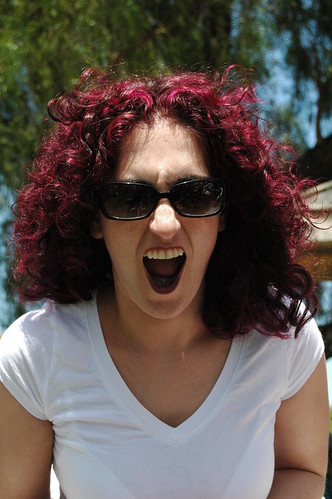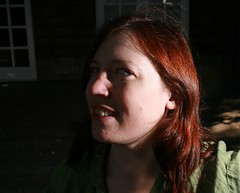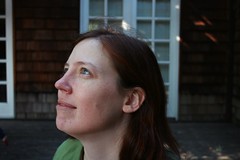Biking around and trailing the toddler is all very well, until you hurt your lower back pushing those pedals, and then have to pick up said toddler. And when I say "you" here, I mean "me" (don't you love the vagueness of the impersonal second person, or "generic you").
The resident expert advised me to pedal faster at lower gears, and to spin the pedals around rather than push them down. Apparently RPMs of more than one per second are common for real cyclists. I started saying "Left, right, left right" to myself to try to get a feel for this rhythm, and it seemed reasonable until I actually got on the bike again and tried to pedal that fast. It feels too fast! Will definitely take some getting used to.
While this may all be very logical and reasonable, it's evidently not what I'm used to. When we were kids we used to have durable, stiff bikes and we'd stand up on the pedals alternately to get moving, putting our full weight on each slow stroke. Besides, the seats were torn up anyway by mistreatment, so why even sit on the seat. I think when I was thirteen, or maybe even twelve, my parents got me a full-size men's mountain bike, figuring it was the last bike they'd buy me before I moved out. It lasted me through university too as I recall. Of course it didn't fit me -- frames for men are too long for most female torsos -- but we didn't know any better about that either.
Wednesday, June 25, 2008
Monday, June 23, 2008
I recently scanned through Flow, by Mihàly Csíkszentmihályi, a book I first read a decade ago. It didn't improve on rereading -- it's not a bad book, but it has the kind of overblown promises I've come to recognize in a certain category of books by obsessed people. Greater world peace, less illness, better personal finances and fewer unwed teen mothers would result if more people learned to experience more flow. Another book in this category is The Promise of Sleep, by Dr. William C. Dement: if only more people got better sleep we'd see better health, less unemployment and many fewer traffic accidents. Any others?
My husband has been ranting about another category of books: books about a particular invention that "changed the world". The smaller the subject the funnier these are, and these are easy to find with an Amazon search:
My husband has been ranting about another category of books: books about a particular invention that "changed the world". The smaller the subject the funnier these are, and these are easy to find with an Amazon search:
- The Machine That Changed the World -- about "lean manufacturing" as introduced by Toyota, basically a PR exercise for Toyota according to reviews.
- Rome 1960: The Olympics that Changed the World
- The Night of the Long Knives: Forty-Eight Hours That Changed the History of the World
- Nixon and Mao: The Week That Changed the World
- The Map That Changed the World: William Smith and the Birth of Modern Geology
- The Gun that Changed the World -- about the Kalashnikov
- Mersey the River That Changed the World
- The Fibre that Changed the World: The Cotton Industry in International Perspective, 1600-1990s
- The Box That Changed the World: Fifty Years of Container Shipping - An Illustrated History
- Tea: The Drink That Changed the World
- Banana: The Fate of the Fruit That Changed the World
- Cod: A Biography of the Fish That Changed the World
Saturday, June 21, 2008
I have a yoga rant today. Why are yoga classes so seldom both strong and safe? By "strong" I mean including poses that take strength to hold, and that are held for five or more long breaths, such that the class overall makes one sweat and improves muscle tone. Load-bearing exercise is important for women of all ages for late-life bone strength, and men seem to like these types of classes better because they include some poses that men are good at.
By "safe" I mean that dangerous poses, ones that can harm the wrists or back or knees, are not as frequent and come with careful instruction and warning, and the teacher explains how to do the pose safely and also explains who should not do the pose. Some of the things I hear from yoga teachers I consider "safe":
Instead, the normal tendency when teachers focus on yoga that doesn't hurt, is to make the whole class easier; while the tendency when building a class for advanced or strong students is to do dangerous poses without teaching how to do them safely.
Anyway, I do know a teacher, currently teaching, who excels at combining strength and safety, although I don't have a schedule that allows me to take her classes right now.
By "safe" I mean that dangerous poses, ones that can harm the wrists or back or knees, are not as frequent and come with careful instruction and warning, and the teacher explains how to do the pose safely and also explains who should not do the pose. Some of the things I hear from yoga teachers I consider "safe":
- Push the base of the fingers down into the mat in poses that put weight on the wrist; this engages the muscles of the hand to protect the wrist.
- Remember to flex the foot in poses that open the hip by using the whole leg as a lever (e.g. the "knee to ankle" pose). Again this activates the muscles that hold the joint solid, rather than stress the ligaments.
- "If this hurts in this way, stop."
Instead, the normal tendency when teachers focus on yoga that doesn't hurt, is to make the whole class easier; while the tendency when building a class for advanced or strong students is to do dangerous poses without teaching how to do them safely.
Anyway, I do know a teacher, currently teaching, who excels at combining strength and safety, although I don't have a schedule that allows me to take her classes right now.
Wednesday, June 18, 2008
I am not experiencing flow doing Django Web form programming. Don't get me wrong, it's powerful and good, but there is something seriously messing with my ability to keep working. As usual, I need to look up Python and Django and HTML forms details every so often, but this is normal and I've been able to maintain focus doing other kinds of programming.
To build Web forms, I create a new HTML page and see that it loads, add a form element and a form field, see if it shows up, add a submit button, test that it works without being wired up, wire it up to a form submission URL and write a dummy handler, see that the dummy handler is called, replace the dummy handler code with real handler code. Each of these steps takes only a minute or two and after many of them I find I have to stop working rather than go on to the next step. It's worst when I have to figure out "what next" when I'm done with one whole form, at least for the time being. Perhaps it's the constant swapping between deciding "What am I doing" and "How do I do what I decided to do".
To build Web forms, I create a new HTML page and see that it loads, add a form element and a form field, see if it shows up, add a submit button, test that it works without being wired up, wire it up to a form submission URL and write a dummy handler, see that the dummy handler is called, replace the dummy handler code with real handler code. Each of these steps takes only a minute or two and after many of them I find I have to stop working rather than go on to the next step. It's worst when I have to figure out "what next" when I'm done with one whole form, at least for the time being. Perhaps it's the constant swapping between deciding "What am I doing" and "How do I do what I decided to do".
Monday, June 09, 2008
This was my route and itinerary by bike last Friday:

I biked three miles to the Palo Alto train station, caught an earlier train than I intended, and arrived 45 minutes early for my 10am meeting at point B. I left there just before 11 am and saw two bridges and much waterfront on my way to point C, where I was 30 minutes early for my noon meeting.
I left C at 1:30 and was 20 minutes early for my 2:30 appointment at point D. Finally I left there at 3:30 and had a last appointment near A before biking back to Caltrain. This SF loop is 12.5 miles according to Google, and I optimized it to have very little hill-climbing but this is SF folks. There were some hills.
The caltrain ride home was very much slowed by a pedestrian accident past Palo Alto, so I got off the train at the unscheduled Menlo Park stop and biked home: 4 miles.
A total of 19.5 miles on bike, all in a skirt with my demo laptop on my back. I loved it!!

I biked three miles to the Palo Alto train station, caught an earlier train than I intended, and arrived 45 minutes early for my 10am meeting at point B. I left there just before 11 am and saw two bridges and much waterfront on my way to point C, where I was 30 minutes early for my noon meeting.
I left C at 1:30 and was 20 minutes early for my 2:30 appointment at point D. Finally I left there at 3:30 and had a last appointment near A before biking back to Caltrain. This SF loop is 12.5 miles according to Google, and I optimized it to have very little hill-climbing but this is SF folks. There were some hills.
The caltrain ride home was very much slowed by a pedestrian accident past Palo Alto, so I got off the train at the unscheduled Menlo Park stop and biked home: 4 miles.
A total of 19.5 miles on bike, all in a skirt with my demo laptop on my back. I loved it!!
Wednesday, June 04, 2008
Tuesday, June 03, 2008
I visited the Asian Art museum of San Francisco a few years ago with a good friend. We were struck by all the buddhist iconography embodied in the hair of painted gods: peaceful gods had softly flowing blue hair, while wrathful deities had fiercely curling fiery red hair. Like Jasmin:

After seeing all these fierce hairdos, my friend and I immediately went home and dyed our hair bright red. But Jasmin really rocks that look!
UPDATED: I didn't mean to imply this photograph is one I took, but I forgot to give credit for it. 'gretch_dragon' took the photo.

After seeing all these fierce hairdos, my friend and I immediately went home and dyed our hair bright red. But Jasmin really rocks that look!
UPDATED: I didn't mean to imply this photograph is one I took, but I forgot to give credit for it. 'gretch_dragon' took the photo.
Monday, June 02, 2008
Some news related to my role as an Applications Area Director, for a change. Last week was the P2P Workshop organized by Jon Peterson and Cullen Jennings. I didn't take any notes so I won't have many names to drop, but I learned a lot. In the morning we heard talks from operations guys at Comcast and by Stanislav Shalunov who works on one of the BitTorrent clients. The basic summary of each of the talks was that despite their differences they'd like to work together and with the IETF or for the good of the Internet. Comcast talked about their commitment to net neutrality and the costs/challenges of providing cable service -- neat stuff about how upload bandwidth is completely separate from download bandwidth, and BitTorrent is unusual among applications in using more upload bandwidth than most. Stanislav talked about all the logic they have in the client he works on to be careful about overloading the network despite having very little information available on how to ration network usage.
In the afternoon, I recall a talk on "Localization". I'm used to this meaning to translate software into another language, but in this case the meaning was to find a server that's "local" in network terms before attempting to do something. Leslie Daigle and Henning Shulzrinne also gave talks.
Some of the takeaways for the Applications area could be:
- Documenting the BitTorrent protocol in a stable document
- Standard on how to find an appropriate mirror or location for a resource that's available on multiple servers -- this is re-implemented all the time in the wild, with different confusing HTML interfaces on each implementation
- Standard on how to find a local server -- this could be a subproblem of the basic service discovery problem (given a particular domain), or it could be more sophisticated (not just one domain but based instead on network topology)
- More ways to find out network information -- this could include information on bandwidth available, bandwidth quota, local servers, caches etc.
I don't know exactly how followup from this meeting may turn into Internet-Drafts, WGs or other, so that's all the information I have for now and no predictions of whether people will actually volunteer to do any of the above. But even as is, I thought the workshop was useful for bringing people closer to the same page.
In the afternoon, I recall a talk on "Localization". I'm used to this meaning to translate software into another language, but in this case the meaning was to find a server that's "local" in network terms before attempting to do something. Leslie Daigle and Henning Shulzrinne also gave talks.
Some of the takeaways for the Applications area could be:
- Documenting the BitTorrent protocol in a stable document
- Standard on how to find an appropriate mirror or location for a resource that's available on multiple servers -- this is re-implemented all the time in the wild, with different confusing HTML interfaces on each implementation
- Standard on how to find a local server -- this could be a subproblem of the basic service discovery problem (given a particular domain), or it could be more sophisticated (not just one domain but based instead on network topology)
- More ways to find out network information -- this could include information on bandwidth available, bandwidth quota, local servers, caches etc.
I don't know exactly how followup from this meeting may turn into Internet-Drafts, WGs or other, so that's all the information I have for now and no predictions of whether people will actually volunteer to do any of the above. But even as is, I thought the workshop was useful for bringing people closer to the same page.
Subscribe to:
Comments (Atom)
Blog Archive
-
▼
2008
(53)
-
▼
June
(8)
- Biking around and trailing the toddler is all very...
- I recently scanned through Flow, by Mihàly Csíksze...
- I have a yoga rant today. Why are yoga classes so...
- I am not experiencing flow doing Django Web form p...
- This was my route and itinerary by bike last Frida...
- Jasmin ordered photos of my red hair and I have co...
- I visited the Asian Art museum of San Francisco a ...
- Some news related to my role as an Applications Ar...
-
▼
June
(8)





